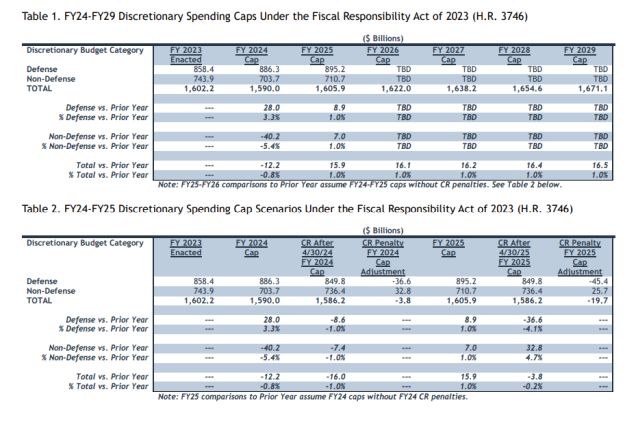On Saturday, June 3, President Biden signed into law the Fiscal Responsibility Act of 2023 (H.R. 3746; the "Act"). In addition to suspending the debt limit through January 1, 2025, the Act implements caps on both non-defense and defense discretionary spending for Fiscal Year (FY) 2024 and FY2025, and caps on total discretionary spending for FY26 through FY29. Amounts are summarized in Table 1 below.
For FY24, non-defense funding is capped at $703.7 billion, $40.2 billion less than the amount Congress appropriated for the current fiscal year, and defense funding will increase by $28 billion to $886.3 billion, approximately 3%. Caps on both discretionary spending categories will then increase by 1% in FY25 unless certain conditions are triggered, as discussed below.
With the FY24 topline spending levels now established, the House and Senate Appropriations Committees are expected to work expeditiously over the next few months to set the individual 302(b) funding totals for each account, mark-up and pass all 12 of the appropriations bills prior to the end of the fiscal year on September 30, 2023.
As an incentive for Congress to complete the appropriations process through regular order, or at least through a process resembling regular order, there is a provision in the Act that has garnered a great deal of attention and confusion: an automatic, across-the-board funding cut of 1% from currently enacted levels, applicable to defense and non-defense funding alike, if Congress fails to pass all of the full-year funding bills before the end of the calendar year.
It has been over 25 years since Congress last passed all of the appropriations bills before the fiscal year-end on September 30. It is not likely that the 118th Congress will break from this now established practice, at least not for FY24. Ironically, the Act takes into account this historical precedent, and, in fact, the key dates to watch are not even in calendar year 2023.
The 1% spending cuts would be triggered on January 1, 2024, if any federal agencies are operating under a short-term continuing resolution (CR), meaning that all government agencies must be funded through September 30, 2024, the end of FY24. These cuts would come into effect for all agencies, even if only a single agency or discretionary account is operating under a short-term CR.
The automatic spending cuts would not go into effect until April 30, 2024, providing Congress with an additional grace period of four months to complete the FY24 appropriations process. Over the past 25 years, Congress has successfully completed the appropriations processes prior to April 30, which is already six months into the fiscal year, on all but one occasion. On May 5, 2017, President Trump signed into law the Consolidated Appropriations Act, 2017 (H.R. 244, 115th Congress).
The Act requires that, for FY25, automatic spending cuts would be triggered the same way as they are for FY24. If any discretionary account is operating under a CR on January 1, 2025, then all FY25 appropriations bills would need to be enacted before April 30, 2025, to avoid an automatic 1% cut from FY23 levels across all appropriations accounts (with limited exceptions.) Amounts are summarized in Table 2 below.
While much of the action is likely to take place after the start of the new fiscal year, September 30, 2023, remains an important date to watch. Congress will need to agree on the terms of a CR in order to avert a government shutdown and to provide appropriators with time to complete their work for FY24.

The content of this article is intended to provide a general guide to the subject matter. Specialist advice should be sought about your specific circumstances.




